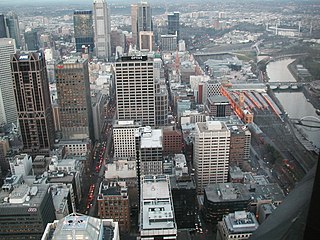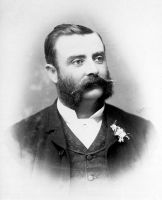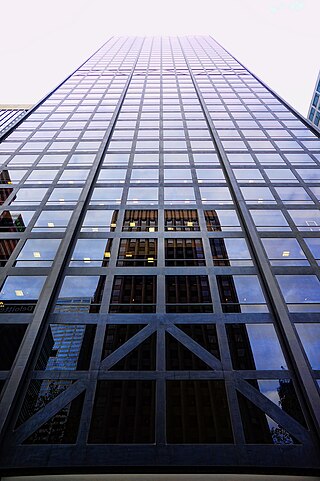
The Hoddle Grid is the contemporary name given to the approximately 1-by-0.5-mile grid of streets that form the Melbourne central business district, Australia. Bounded by Flinders Street, Spring Street, La Trobe Street, and Spencer Street, it lies at an angle to the rest of the Melbourne suburban grid, and so is easily recognisable. It is named after the surveyor Robert Hoddle, who marked it out in 1837, establishing the first formal town plan. This grid of streets, laid out when there were only a few hundred settlers, became the nucleus for what is now Melbourne, a city of over five million people.

Queen Victoria Village, generally known as QV Melbourne or just QV, is a precinct in the Melbourne central business district, Victoria, Australia. Covering the city block bounded by Lonsdale, Little Lonsdale, Swanston, and Russell Streets, and located directly opposite the State Library of Victoria and Melbourne Central, QV comprises a large shopping centre, a central plaza, an underground food court, Melbourne central city's first full-size supermarket and apartment buildings.

Collins Street is a major street in the central business district of Melbourne, Victoria, Australia. It was laid out in the first survey of Melbourne, the original 1837 Hoddle Grid, and soon became the most desired address in the city. Collins Street was named after Lieutenant-Governor of Tasmania David Collins who led a group of settlers in establishing a short-lived settlement at Sorrento in 1803.

William Pitt was an Australian architect and politician. Pitt is best known as one of the outstanding architects of the "boom" era of the 1880s in Melbourne, designing some of the city's most elaborate High Victorian commercial buildings. He worked in a range of styles including Gothic Revival, Italianate, French Second Empire, and his own inventive eclectic compositions. He had a notable second career after the crash of the 1890s, becoming a specialist in theatres and industrial buildings.
Nahum Barnet was an architect working in Melbourne, Victoria, Australia during the Victorian and Edwardian periods, best known for his extensive legacy of commercial buildings in Melbourne's CBD, as well as his last design, the Melbourne Synagogue.

The Melbourne cable tramway system was a cable car public transport system, which operated between 1885 and 1940 in Melbourne, Victoria, Australia.

St James Old Cathedral, an Anglican church, is the oldest church in Melbourne, Australia, albeit not on its original site. It is one of the relatively few buildings in the central city which predate the Victorian gold rush of 1851. The building was dismantled and relocated in 1914 to a corner site of King Street and Batman Street.

Lonsdale Street is a main street and thoroughfare in the Melbourne central business district, Australia. It runs roughly east–west and was laid out in 1837 as one of Melbourne's original boundaries within the Hoddle Grid. The street extends from Spring Street in the east to Spencer Street in the west.

101 Collins Street is a 260 m (850 ft) skyscraper located in Collins Street, Melbourne central business district, Victoria, Australia. The 57-storey building designed by Denton Corker Marshall was completed in March 1991. Towards the end of project, with a change of developer, the foyer space was designed by John Burgee, noted as a pioneer of postmodern architecture.
Harry Norris was an Australian architect, one of the more prolific and successful in Melbourne in the interwar period, best known for his 1930s Art Deco commercial work in the Melbourne central business district.
Australian non-residential architectural styles are a set of Australian architectural styles that apply to buildings used for purposes other than residence and have been around only since the first colonial government buildings of early European settlement of Australia in 1788.

140 William Street is a 41-storey 152m tall steel, concrete and glass building located in the western end of the central business district of Melbourne, Victoria, Australia. Constructed between 1969 and 1972, BHP House was designed by the architectural practice Yuncken Freeman alongside engineers Irwinconsult, with heavy influence of contemporary skyscrapers in Chicago, Illinois. The local architects sought technical advice from Bangladeshi-American structural engineer Fazlur Rahman Khan, of renowned American architectural firm Skidmore, Owings & Merrill, spending ten weeks at its Chicago office in 1968. At the time, BHP House was known to be the tallest steel-framed building and the first office building in Australia to use a “total energy concept” – the generation of its own electricity using BHP natural gas. The name BHP House came from the building being the national headquarters of BHP. BHP House has been included in the Victorian Heritage Register for significance to the State of Victoria for following three reasons:

The Colonial Bank of Australasia was a bank operating primarily in the Australian colony and then state of Victoria from 1856 to 1918.

The Melbourne central business district in Australia is home to numerous lanes and arcades. Often called "laneways", these narrow streets and pedestrian paths date mostly from the Victorian era, and are a popular cultural attraction for their cafes, bars and street art.

Brigadier Sir Bernard Evans, was an Australian army officer, architect, builder and Lord Mayor of Melbourne (1959–1961).

The Federal Coffee Palace was a large, elaborate French Second Empire style 560 room temperance hotel in the city centre of Melbourne, Victoria, built between 1886 and 1888 at the height of the city's 1880s land boom, and demolished in 1972-73. Located on Collins Street, the premier thoroughfare, on the corner of King Street, near Spencer Street Station, it is prominent in lists of the buildings Melburnians most regret having lost.

The architecture of Melbourne, the capital of the state of Victoria and second most populous city in Australia, is characterised by a wide variety of styles in various structures dating from the early years of European settlement to the present day. The city is particularly noted for its mix of Victorian architecture and contemporary buildings, with 74 skyscrapers in the city centre, the most of any city in the Southern Hemisphere.
William Arthur Purnell FRAIA, generally known as Arthur Purnell, and sometimes A W Purnell, was an Australian-born architect who practised in Canton, China, in the 1900s, and from 1910 mainly in Melbourne, Australia. He is most noted for the few designs in Melbourne that include Chinese references.















